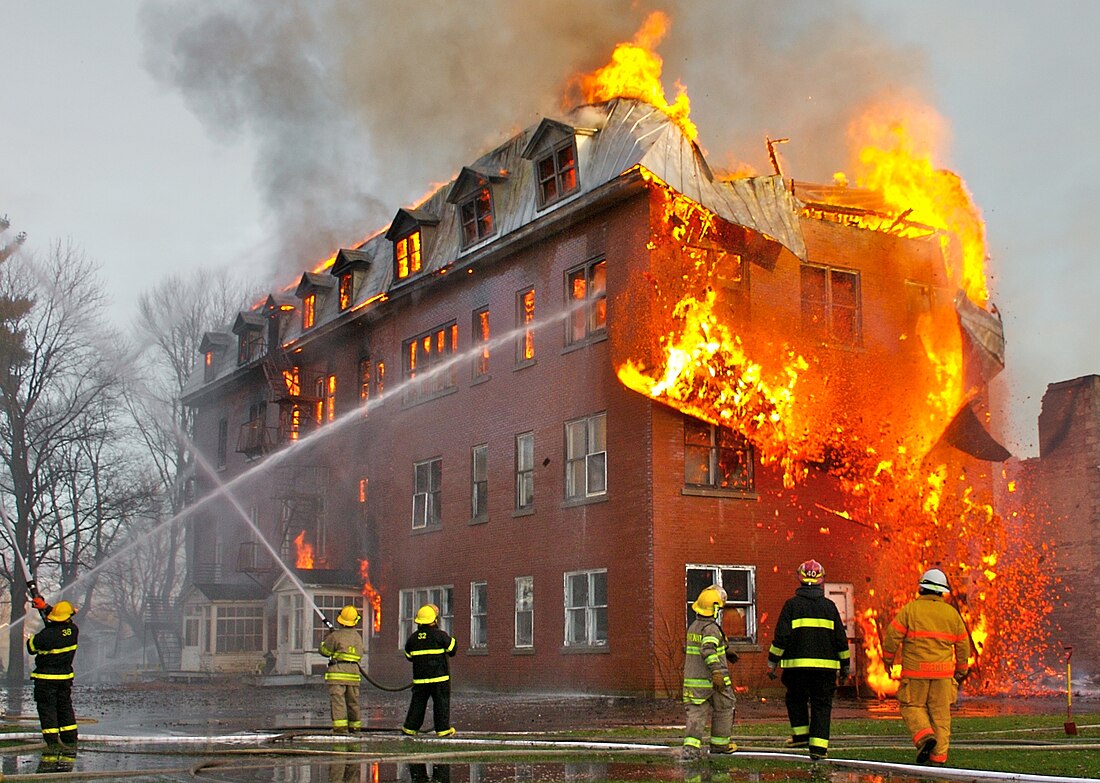Top Qs
Timeline
Chat
Perspective
Structure fire
Type of fire From Wikipedia, the free encyclopedia
Remove ads
A structure fire is a fire involving the structural components of various types of residential, commercial or industrial buildings, such as barn fires. Residential buildings range from single-family detached homes and townhouses to apartments and tower blocks, or various commercial buildings ranging from offices to shopping malls. This is in contrast to "room and contents" fires, chimney fires, vehicle fires, wildfires or other outdoor fires.
This article includes a list of references, related reading, or external links, but its sources remain unclear because it lacks inline citations. (September 2013) |

Structure fires typically have a similar response from the fire department that include engines, ladder trucks, rescue squads, chief officers, and an EMS unit, each of which will have specific initial assignments. The actual response and assignments will vary between fire departments.
It is not unusual for some fire departments to have a predetermined mobilization plan for when a fire incident is reported in certain structures in their area. This plan may include mobilizing the nearest aerial firefighting vehicle to a tower block, or a foam-carrying vehicle to structures known to contain certain hazardous chemicals.
Remove ads
Types (United States)
In the United States, according to NFPA, structures are divided into five construction types based on the severity of the fire hazard:
| Type I: Fire Resistive | Typically used in high-rises. The material comprising the structure is either inherently able to withstand significant exposure to fire (concrete), or in which a fire resistive covering is applied to steel structural members. |
| Type II: Non-combustible | Typically used in strip shopping center malls. Roofs are constructed out of steel rafters. |
| Type III: Ordinary construction | Brick and mortar walls, wood frame floors. City rowhouses are where this type of construction is most often found. |
| Type IV: Heavy timber | Often used in churches or other community-based buildings. |
| Type V: Wood frame | Typically used in recent construction of single-family dwellings, townhouses, garden apartments with four floors or less. |
- Remains of a structure fire on Cotton Avenue, Macon, Georgia, US. c. 1876
- A burned-out house
Remove ads
Causes of house fires
Summarize
Perspective
The examples and perspective in this section may not represent a worldwide view of the subject. (January 2025) |
Canada
Information from Canada's National Fire Information Database shows these ignition sources for residential fires in 2014.
A 2023 update from Statistics Canada confirmed that cooking equipment and smoker's material continued to be the top causes of residential fires, at 32% and 25% of total incidents respectively.[2]
United States
Data from the U.S. Fire Administration's National Fire Incident Reporting System shows that cooking has consistently been the leading cause of residential building fires.[3]
Remove ads
See also
References
External links
Wikiwand - on
Seamless Wikipedia browsing. On steroids.
Remove ads


